Research on the Value of Water-Related Cultural Heritage Architecture from Historical Environmental Records: Evidence from the Li River Basin in China
Abstract
:1. Introduction
2. Study Area and Data Sources
2.1. Study Area
2.2. Data Sources
2.2.1. Historical Geographic Information Data on WRCHA
2.2.2. Multisource Data Integration and Processing
3. Research Methodology
3.1. Average Nearest Neighbor Index
3.2. Kernel Density Analysis
3.3. Relevance Analysis
3.4. Drought–Flood Classification Method and Sequence Reconstruction
3.5. Random Forests Regression
4. Results and Discussion
4.1. Analysis of the Spatial and Temporal Distribution Characteristics and Patterns of WRCHA
4.2. Analysis of the Spatial and Temporal Distributions of the WRCHA Related to the Environment
4.2.1. Elevation and Terrain Cluster Analyses
4.2.2. Relationships with River Network Systems and Distribution Patterns
4.2.3. Analysis of the Variability in the Hydroclimatic Environment
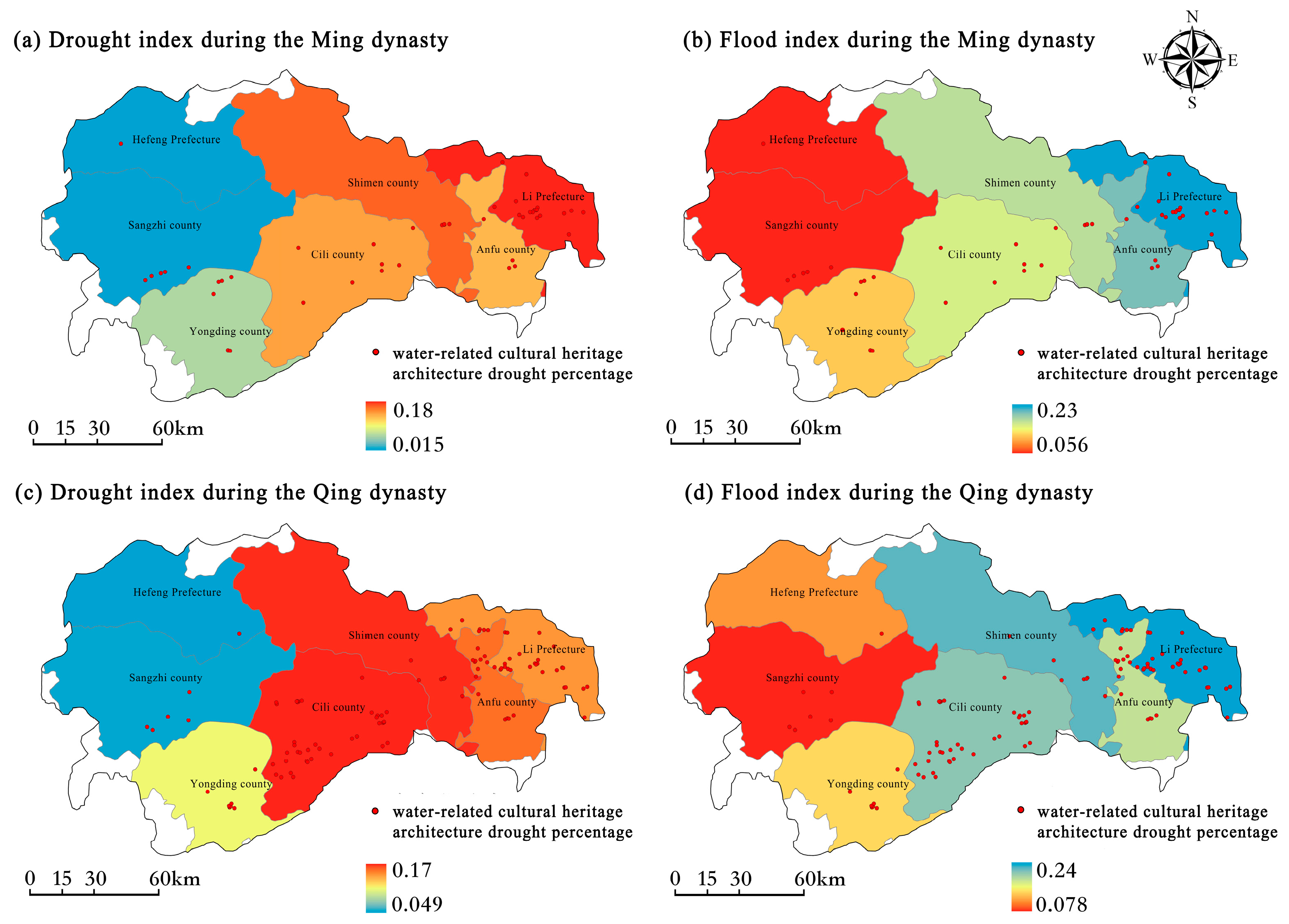
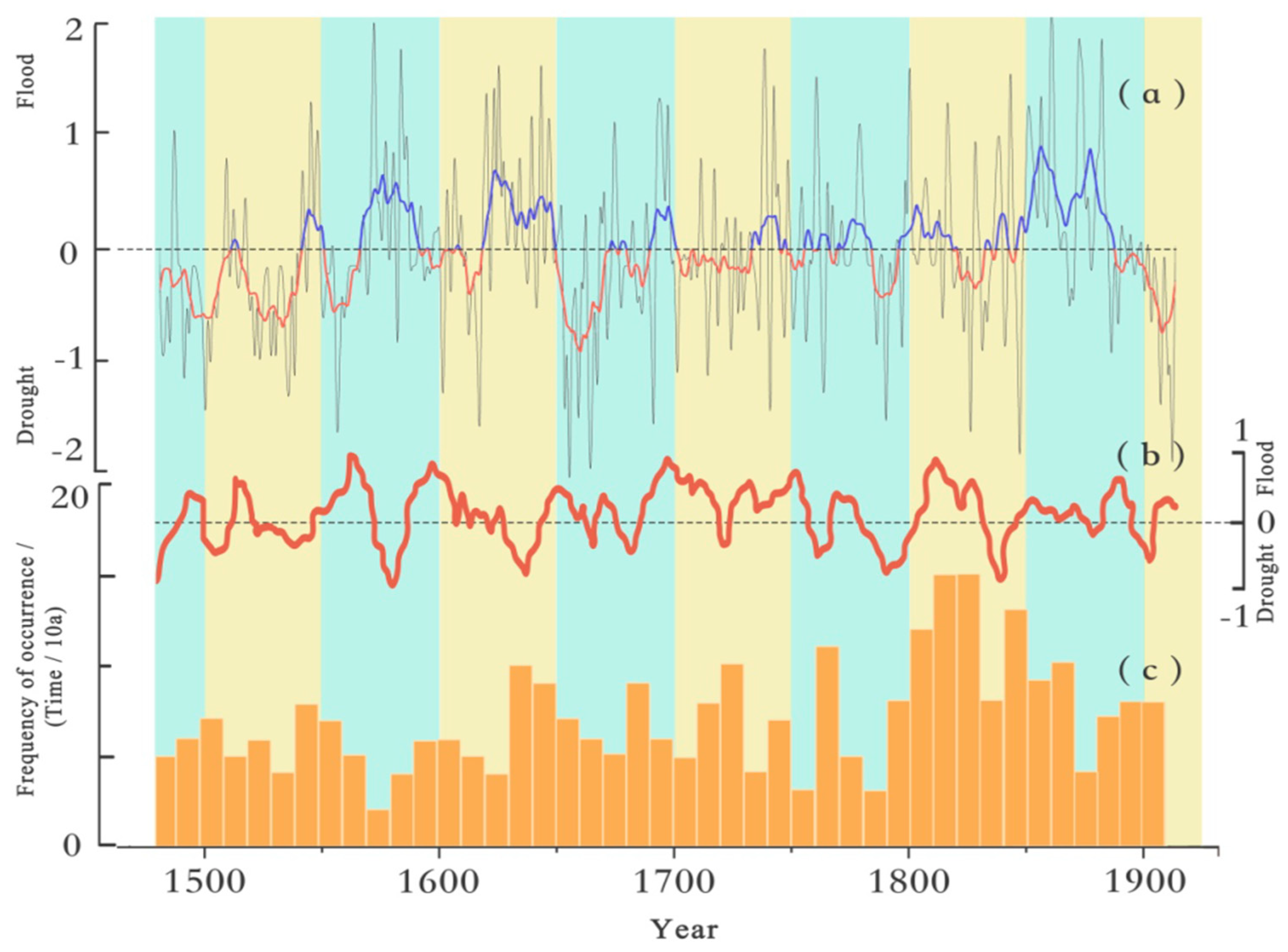
4.2.4. Analysis of the Documentation of WRCHA in Relation to Socioenvironmental Change
4.2.5. Analysis of the Significance of Influencing Factors
5. Conclusions
- (1)
- Spatial and Temporal Distribution Patterns of the WRCHA in the Li River Basin
- (2)
- Spatial and temporal distributions of the WRCHA and the factors affecting them
Author Contributions
Funding
Data Availability Statement
Acknowledgments
Conflicts of Interest
References
- Fanen, K.; Hailong, L.I.U. Value characteristics and cognitive development of “water cultural heritage”. Landsc. Archit. 2022, 29, 59–64. [Google Scholar] [CrossRef]
- Dai, T.; Hein, C. Exploring the descriptions of World Heritage properties through the perspective of water using a narrative approach. Int. J. Herit. Stud. 2023, 29, 1315–1338. [Google Scholar] [CrossRef]
- Gu, Y.S.; Li, K.J.; Qin, Y.M.; Qi, S.H.; Ge, J.W.; Li, W. Human activities and the ecological environment evolution of Jianghan Lake Group during historical periods. Earth Sci. 2013, 38, 133–144. [Google Scholar]
- Suganya, K.; Harshavardhan, M.; Rajani, M.B. Hydrological maps as a tool for the exploration of historical water systems at Badami, Karnataka, India. Water Hist. 2022, 14, 309–333. [Google Scholar] [CrossRef]
- Brokerhof, A.W.; van Leijen, R.; Gersonius, B. Protecting Built Heritage against Flood: Mapping Value Density on Flood Hazard Maps. Water 2023, 15, 2950. [Google Scholar] [CrossRef]
- Kawanabe, H. Cultural associations in an ancient lake: Gods of water in Lake Biwa and the River Yodo basin, Japan. Hydrobiologia 2003, 500, 213–216. [Google Scholar] [CrossRef]
- Wang, W.; Wang, L. The influence of witchcraft culture on ancient Chinese water relations-a case study of the Yellow River Basin. Eur. J. Remote Sens. 2020, 53 (Suppl. S1), 93–103. [Google Scholar] [CrossRef]
- Appiotti, F.; Assumma, V.; Bottero, M.; Campostrini, P.; Datola, G.; Lombardi, P.; Rinaldi, E. Definition of a risk assessment model within a European interoperable database platform (EID) for cultural heritage. J. Cult. Herit. 2020, 46, 268–277. [Google Scholar] [CrossRef]
- Wang, Y.W.; Pendlebury, J.; Nolf, C. The water heritage of China: The polders of Tai Lake Basin as continuing landscape. Plan. Perspect. 2023, 38, 949–974. [Google Scholar] [CrossRef]
- Pearson, N.; Thompson, B.S. Saving two fish with one wreck: Maximizing synergies in marine biodiversity conservation and underwater cultural heritage protection. Mar. Policy 2023, 152, 105613. [Google Scholar] [CrossRef]
- Geraldi, A.M. Natural and cultural heritage of lagoon water bodies. The origin of tourism in Carhué, Buenos Aires, Argentina. PASOS Rev. Tur. Patrim. Cult. 2023, 21, 177–193. [Google Scholar] [CrossRef]
- Du, L.; Peng, X.; Zhao, Y.; Lyu, J.; Pan, M. From nature-based to engineering-based: The interaction process and turning point of the city-water system relationship in the North China plain. Appl. Geogr. 2021, 135, 102556. [Google Scholar] [CrossRef]
- Hu, D.; Yao, B.; Sun, S.; Xu, H. Spatiotemporal distribution characteristics of precipitation in the Li River Basin. J. Hunan Agric. Univ. 2011, 37, 558–561. [Google Scholar]
- Ge, Q.; Zheng, J.; Tian, Y.; Wu, W.; Fang, X.; Wang, W.-C. Coherence of climatic reconstruction from historical documents in China by different studies. Int. J. Climatol. 2008, 28, 1007–1024. [Google Scholar] [CrossRef]
- Hunan Provincial Water Conservancy Journal Compilation Office. Hunan Water Conservancy Construction; Hunan Provincial Water and Electricity Office: Changsha, China, 1990. [Google Scholar]
- Shu, T. Dongting Lake Journal; YueLu Press: Changsha, China, 2003. [Google Scholar]
- Xianlie, Y.; Kaili, C. Jiaqing Changde Prefectural Records; YueLu Press: Changsha, China, 2008. [Google Scholar]
- Sangzhi County Local History Editorial Committee. Sangzhi County Record; Hubei People’s Publishing House: Wuhan, China, 1990. [Google Scholar]
- Editorial Committee of Dayong County Local History. Dayong County Record; SanLian Publishing House: Shanghai, China, 1995. [Google Scholar]
- Cili County Compilation Committee. Cili County Record; Agricultural Publisher: Pyrmont, NSW, Australia, 1990. [Google Scholar]
- ShiMen County Water Resources and Water Conservancy Bureau. Shimen County Water Conservancy Journal; China Literature and History Press: Beijing, China, 1993. [Google Scholar]
- Yufen, H.; Shi, W. TongZhi Govern Directly Li Province Local Records; YueLu Press: ChangSha, China, 2010. [Google Scholar]
- Shouquan, G. A Commentary on the “Li Ji”; Famous Publishing House: London, UK, 2010. [Google Scholar]
- Jin City Records Compilation Committee. Jin County Record; Educational Science Publishing House: Shanghai, China, 1993. [Google Scholar]
- Linli County Historical Records Editorial Committee. Linli County History; China Social Press: Beijing, China, 1992. [Google Scholar]
- Wen, K.G. Dictionary of Meteorological Disasters in China. Hunan Volume; Meteorological Press: Beijing, China, 2006. [Google Scholar]
- Institute of Meteorology, Central Meteorological Administration. Atlas of the Distribution of Droughts and Floods in China in the Last 500 Years; Map Press: Baltimore, MD, USA, 1981. [Google Scholar]
- Hunan Institute of History and Archaeology. Chronology of Natural Disasters in Hunan; Hunan People’s Publishing House: Changsha, China, 1961. [Google Scholar]
- Li, X. Daming Yitongzhi; Sanqin Publishing House: Xi’an, China, 1990. [Google Scholar]
- Xue, G.; Wu, T. Jiajing Huguang Tujing Zhi Shu; Bibliographic Literature Press: New Haven, CT, USA, 1991. [Google Scholar]
- Xue, G. Hunan and Guangdong General Records; Jiangsu Guangling Ancient Books Engraving and Printing Society: New Haven, CT, USA, 1991. [Google Scholar]
- Xu, X. Spatial Distribution of GDP in China km Grid Dataset. Data Registration and Publishing System of the Center for Resource and Environmental Science and Data, Chinese Academy of Sciences. 2017. Available online: https://www.resdc.cn/DOI/doi.aspx?DOIid=33 (accessed on 1 June 2022).
- Li, Y. A Brief History of the Evolution, Development and Governance of Dongting Lake; Hunan Province Dongting Lake Regional Economic and Social Development Research Association: Changsha, China, 2014; p. 67. [Google Scholar]
- Ge, Q.S.; Wang, W.Q. Population pressure, climate change and the Taiping Rebellion. Geogr. Res. 1995, 14, 32–41. [Google Scholar]
- Xue, W. Spss Statistical Analysis Method and Application; Electronic Industry Press: Beijing, China, 2009; p. 484. [Google Scholar]
- Renquan, Z.; Xing, L.; Lianfa, S.; Menggui, J.; Zhenhua, L.; Guoliang, Z.; Jiangao, P.; Mingfu, W.; Wenzhong, D. The contribution of tectonic subsidence to the evolution of the Dongting Lake area in modern times—Answer to Mr. Li Chunchu’s question on the “Analysis of the Geological Environment System of Dongting Lake”. In Ocean Lake; CRC Press: Boca Raton, FL, USA, 2001; pp. 690–696. [Google Scholar]
- Yang, G.; Chen, Z.; Jiang, J. Drainage morphometry of the Lishui catchment in the middle Yangtze basin, China: Morphologic and tectonic implications. Arab. J. Geosci. 2020, 13, 561. [Google Scholar] [CrossRef]
- Zhang, J. Reconstruction and characteristic diagnosis of drought and flood sequence in the middle reaches of the Yellow River from 1644 to 2009. Geogr. Res. 2013, 32, 1579–1590. [Google Scholar]
- Wang, S.; Ye, J.; Gong, D. Climate of the Little Ice Age in China. Quat. Res. 1998, 54–64. [Google Scholar]
- Yang, B.; Braeuning, A.; Johnson, K.R.; Yafeng, S. General characteristics of temperature variation in China during the last two millennia. Geophys. Res. Lett. 2002, 29, 38-1–38-4. [Google Scholar] [CrossRef]
- Jiang, T.; Zhang, Q.; Wang, S. Relationship between droughts and floods and climate change in the middle and lower reaches of the Yangtze River in the past 1000 years. Quat. Res. 2004, 518–524. [Google Scholar]
- Li, Y.; Zhou, L.; Yu, S.; Zhang, D.; Wang, P. Research on spatiotemporal changes in historical flood events in the Yangtze River main stream in the past two thousand years. Earth Environ. 2022, 50, 241–251. [Google Scholar] [CrossRef]
- Zhang, C. Research on the Interaction between Natural Disasters and the Social Economy of the Jianghuai Region during the Ming and Qing Dynasties. Ph.D. Thesis, Xiamen University, Xiamen, China, 2004. [Google Scholar]
- Yu, G.; Hu, S.; Li, C. Discussion on the occurrence years and water level elevation of historical extreme floods in Taihu Lake. Quat. Res. 2013, 33, 167–178. [Google Scholar]

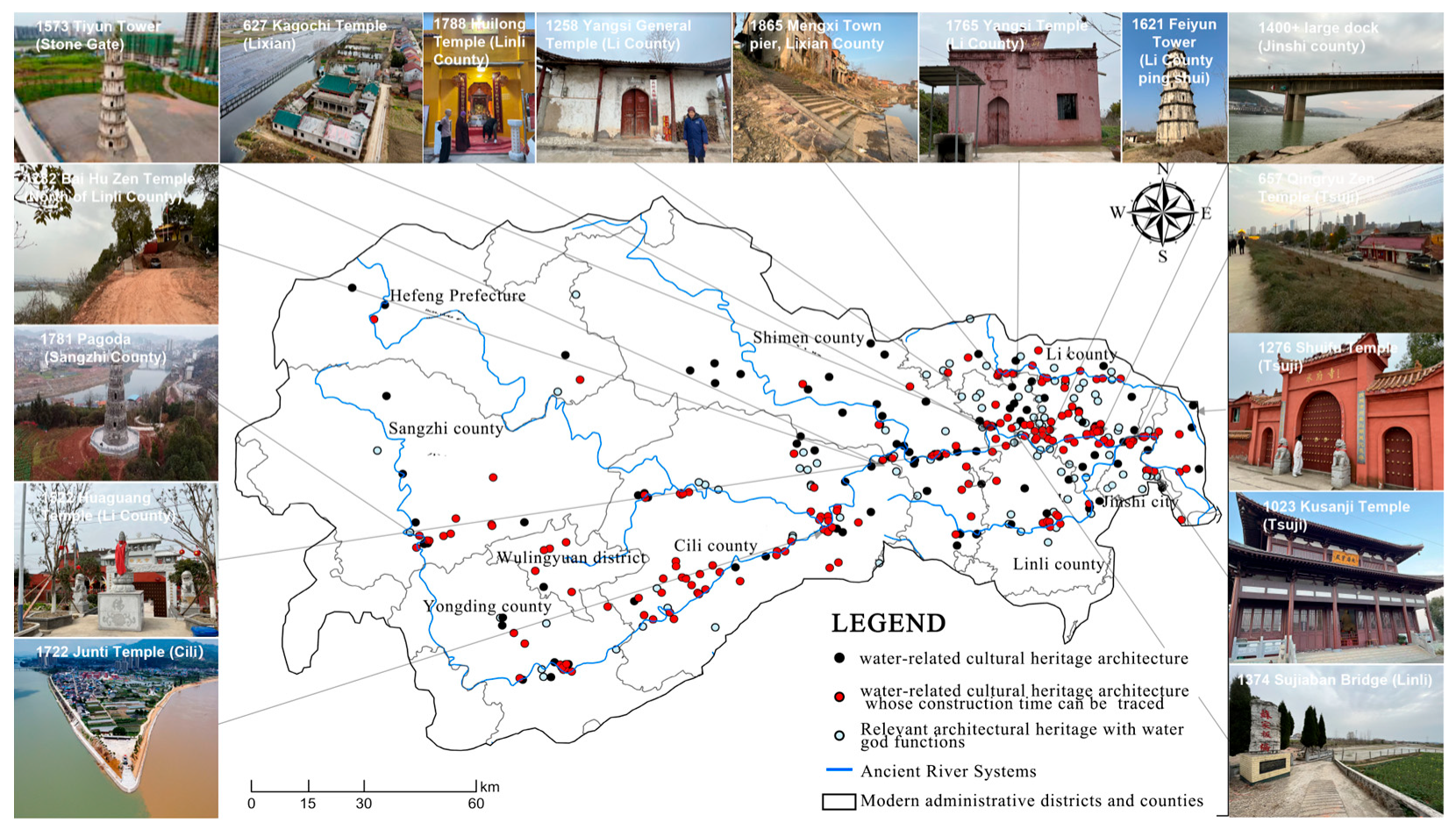


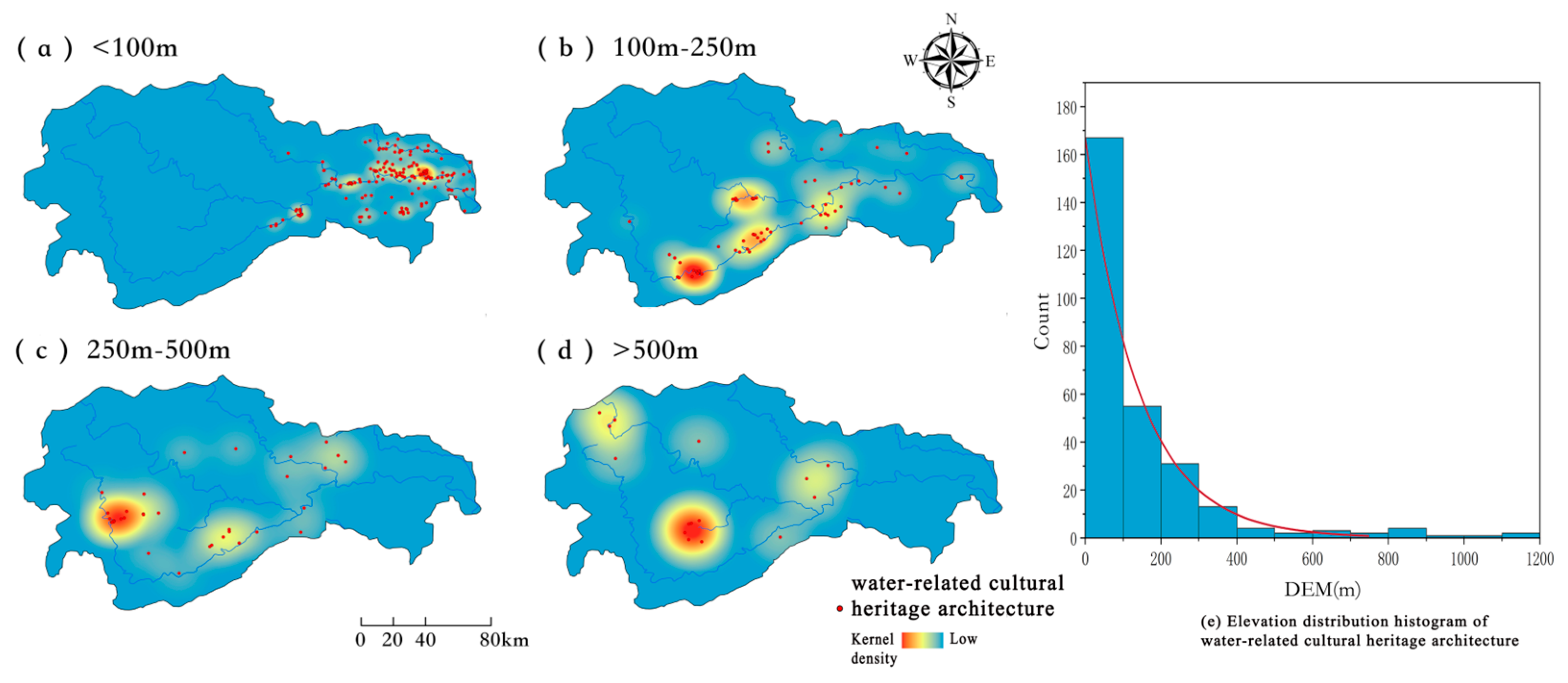


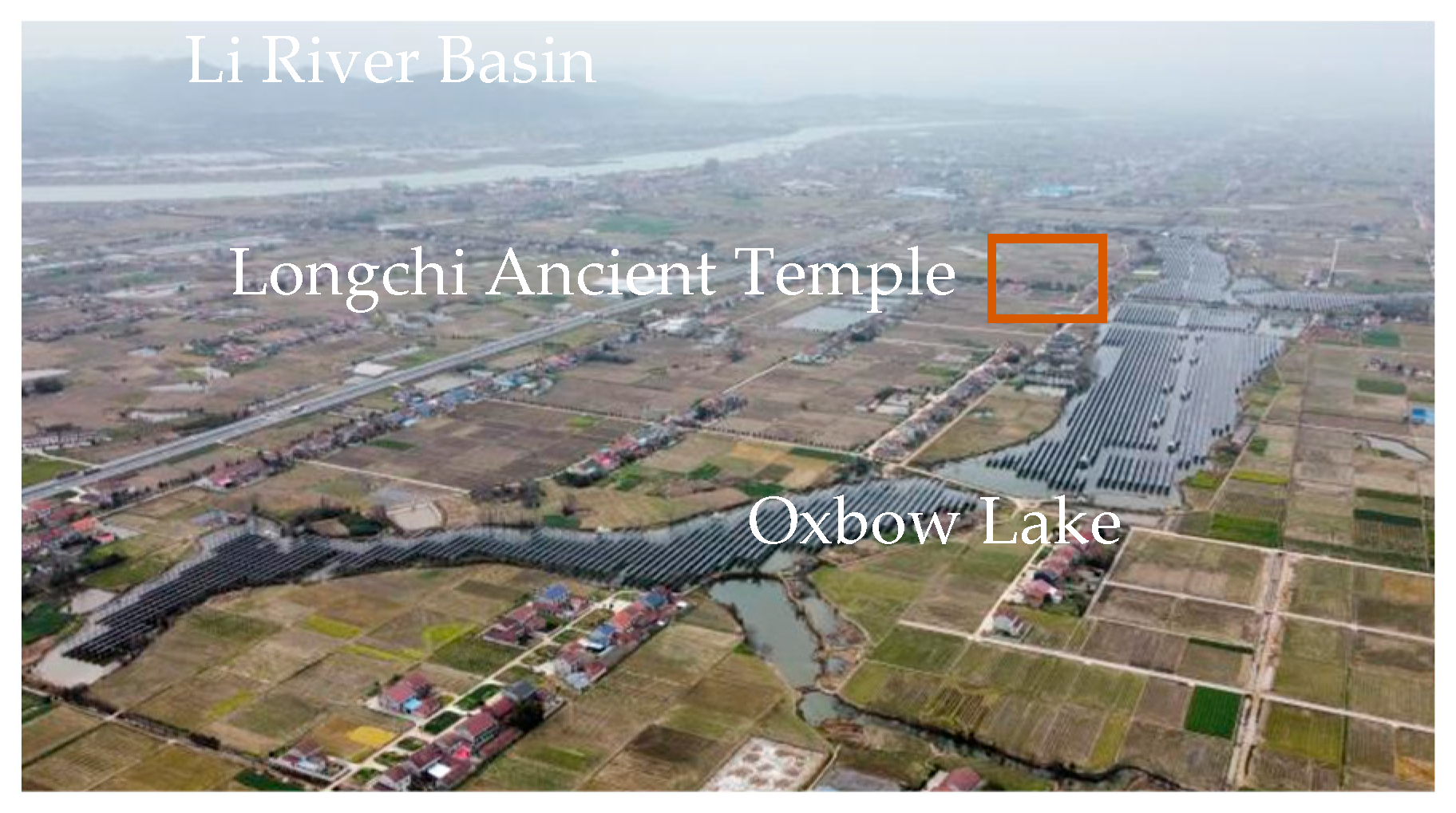

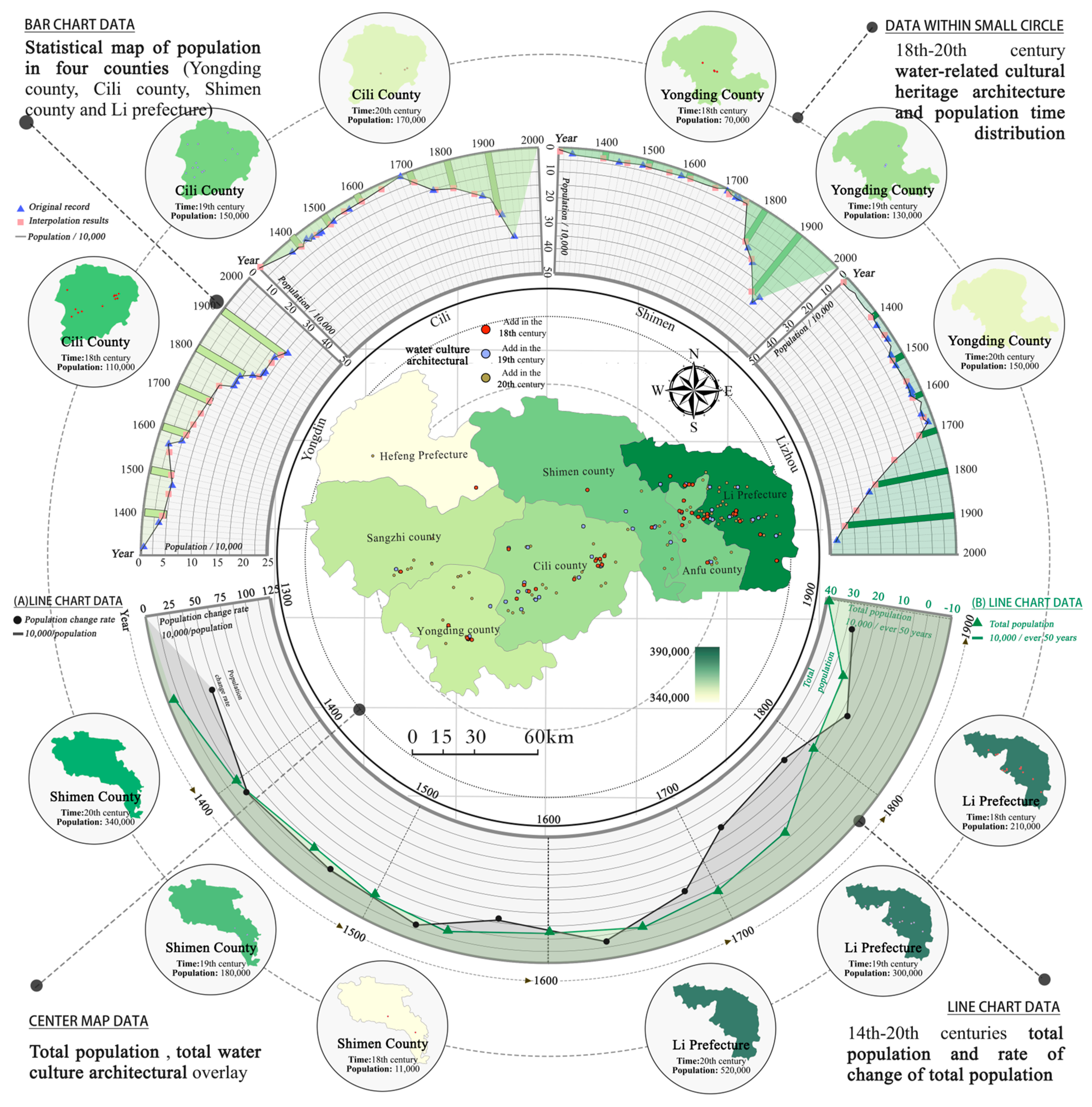

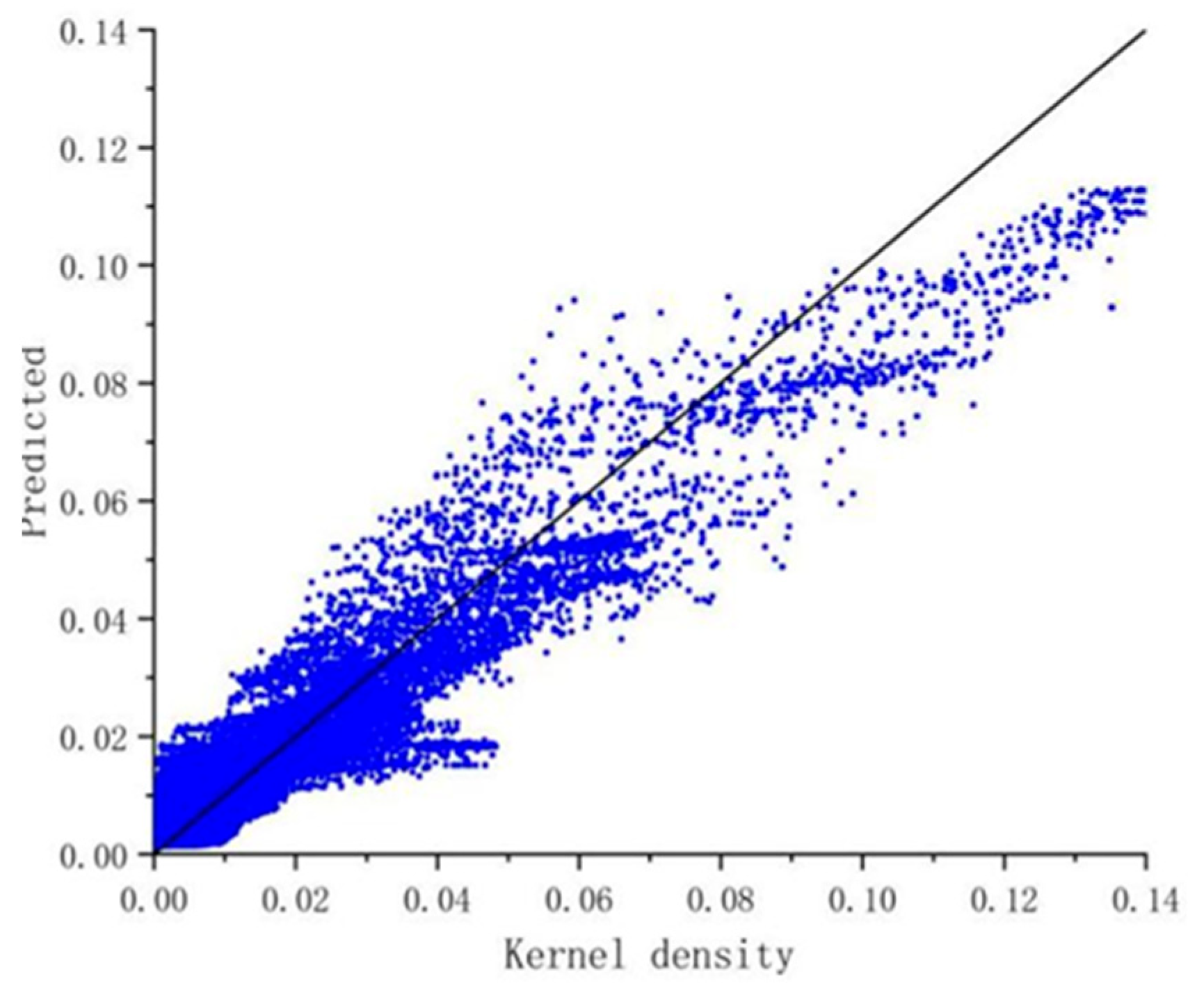
| Data Name | Description of Data Content | Data Sources |
|---|---|---|
| Ming and Qing populations | Average population data for the river subcounties in the 18th–20th centuries | Ancient texts and modern summary materials, as well as historical records from various counties in the Li River Basin during the Ming and Qing dynasties; interpolation and supplementation [15,16,17,18,19,20,21,22,23,24,25,26,27,28,29,30,31] |
| Drought–flood levels | Sequence of drought–flood levels in the river, 1468–1911 | |
| Information on WRCHA data | Historical spatial location, time of construction and collapse, elevation, latitude and longitude, and rasterization | County records, ancient books, ancient maps, archaeology, and research interviews [15,16,17,18,19,20,21,22,23,24,25,26,27,28,29,30,31] |
| Li River Basin base map | Li River Basin water system and water conservancy engineering map | Hunan Li River Basin Water Conservancy and Water Conservancy Development Limited Liability Company |
| Modern river network | Includes multilevel water systems within the Li River Basin | Geographic Data Sharing Platform, School of Urban Environmental Studies, PKU |
| Ancient prefectures, governorships, and water systems | River channel data for the main stream of the river and its first-order tributaries in 1820 (projection of supplementary channel water) | China Historical Geographic Information System (CHGIS); ArcGIS 10.8 extraction calculations |
| Distance from the river | Euclidean metric between the WRCHA and the main tributaries of the river | CAS Resource and Environmental Science Data Registration and Publication System [32]; ArcGIS 10.8 extraction |
| Distance from the ancient seat | Euclidean metric between the WRCHA and ancient county administrative centers | |
| Altitude | 30 m elevation data for Li River Basin | |
| Slope direction, gradient | Fine-tuning the slope modulus to classify 0–40° slope data into five categories slope direction was classified into positive (135–315°) and negative (0–135° and 315–360°) slopes |
| Variable | Importance | |
|---|---|---|
| Population | 0.030908 | |
| DEM | 0.178720 | |
| Slope direction | 0.000020 | |
| Distance from river | 0.026117 | |
| Gradient | 0.000415 | |
| Distance to ancient government site | 0.159007 | |
| River density | Ancient River | 0.069077 |
| Modern River | 0.172525 | |
Disclaimer/Publisher’s Note: The statements, opinions and data contained in all publications are solely those of the individual author(s) and contributor(s) and not of MDPI and/or the editor(s). MDPI and/or the editor(s) disclaim responsibility for any injury to people or property resulting from any ideas, methods, instructions or products referred to in the content. |
© 2024 by the authors. Licensee MDPI, Basel, Switzerland. This article is an open access article distributed under the terms and conditions of the Creative Commons Attribution (CC BY) license (https://creativecommons.org/licenses/by/4.0/).
Share and Cite
Dai, Q.; Wei, Y.; Hu, Y.; Chen, T.; Yan, Y.; Gu, Y.; Wang, Q. Research on the Value of Water-Related Cultural Heritage Architecture from Historical Environmental Records: Evidence from the Li River Basin in China. Land 2024, 13, 838. https://doi.org/10.3390/land13060838
Dai Q, Wei Y, Hu Y, Chen T, Yan Y, Gu Y, Wang Q. Research on the Value of Water-Related Cultural Heritage Architecture from Historical Environmental Records: Evidence from the Li River Basin in China. Land. 2024; 13(6):838. https://doi.org/10.3390/land13060838
Chicago/Turabian StyleDai, Qifan, Yueqing Wei, Yequan Hu, Tao Chen, Yixun Yan, Yansheng Gu, and Qi Wang. 2024. "Research on the Value of Water-Related Cultural Heritage Architecture from Historical Environmental Records: Evidence from the Li River Basin in China" Land 13, no. 6: 838. https://doi.org/10.3390/land13060838




